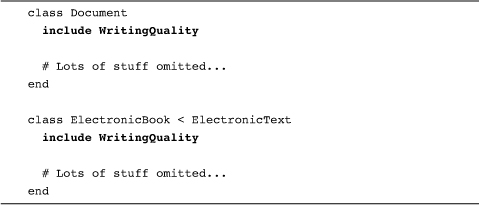Chapter 16. Use Modules as Mixins
I started off the last chapter by pointing out that a class is a combination of two things, a container and a factory. We build classes full of code (that’s the container part) and then we use them to manufacture instances. One thing that I glossed over in the last chapter is that along with being containers and factories, Ruby classes can also be super: Like classes in most other object oriented programming languages, Ruby classes are arranged in an inheritance tree, so that a key part of constructing a new class is picking its parent, or superclass.
In this chapter we are going to discover that you can also insert, or “mix in,” modules into the inheritance tree of your classes. If you haven’t come across the idea of a mixin before, let me whet your appetite. Mixins allow you to easily share common code among otherwise unrelated classes. Mixins are custom-designed for those situations where you have a method or six that need to be included in a number of different classes that have nothing else in common. During our tour of mixin modules we’ll have a good look at how they work and at how real some real Ruby applications like Rails use mixins.
Better Books with Modules
Let’s begin our look at mixins by continuing our quest to improve—or at least measure—the quality of prose entrusted to our Document class. Recall that we’ve already written a method to measure the average length of the words in our documents. There is, however, more to good writing than modestly sized words. Editors also tend to frown on clichés, those phrases that have been so overused that they’ve lost all their rhetorical pizzazz. We decide that an array of regular expressions along with a new Document method1 will do the trick. So we are off and running:

This number_of_cliches method is like much of the code we write—not terribly exciting, but useful nevertheless. So, you release your new Document class and everyone is happy. Unfortunately—at least for you—your employers decide that there might be a world beyond traditional paper books and begin to move into the digital market. To this end, they buy an eBook publishing system, which features its own class hierarchy for representing books:

This is a problem because everyone loves the number_of_cliches method so much that they would like to get it into the new ElectronicBook class. So how do you insert a method into these two, very separate class hierarchies?
Your gut reaction—at least if your gut went to the same object oriented programming school as mine—might be to create some sort of common superclass for both ElectronicBook and Document, maybe Tome. This superclass would contain the number_of_cliches method, which would then be neatly inherited by both ElectronicBook and Document. Sensible, but not always doable. Sometimes, especially in cases where you have inherited large bodies of code, it’s just not practical to rewire the basic structure of your classes in order to share a few tens of lines of code.2
Mixin Modules to the Rescue
The way to solve the problem of sharing code among otherwise unrelated classes is by creating a mixin module. Let’s take this step by step: First, you move the number_of_cliches method into a module:
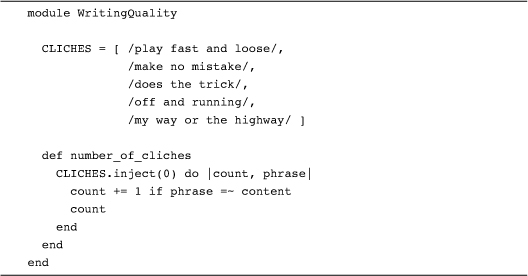
Note that the number_of_cliches method is an ordinary instance method in the module, not a module-level method. Next, you include the module into the classes that need the method:
And you are done. When you include a module into a class, the module’s methods magically become available to the including class, which means that you can now say this:

As well as this:
![]()
The Ruby jargon is that by including a module in a class you have mixed it in to the class. We say that the module itself, WritingQuality in this case, is a mixin module. A very useful aspect of mixins is that they are not limited by the “one superclass is all you get” rule. You can mix as many modules into a class as you like. For example, if you created ProjectManagement and AuthorAccountTracking modules for your publishing employer, you could include them both in the ElectronicBook class, along with WritingQuality:

In practice, this means that if you have several unrelated classes that need to share some code, you don’t have to resort to restructuring your whole inheritance tree to get at that code. All you need to do is wrap the common stuff in a module and include that module in the classes that need it.
Extending a Module
Sometimes it’s the class itself—as opposed to the instances of the class—that needs help from a module. Sometimes you want to pull in a module so that all the methods in the module become class methods. You might, for instance, have a module full of methods that know how to locate documents:

You would like to get the Finders methods into your Document class as class methods. One way to get this done is to do this:

This code includes the module into the singleton class of Document, effectively making the methods of Finders singleton—and therefore class—methods of Document:
war_and_peace = Document.find_by_name( 'War And Peace' )
Including modules into the singleton class is a common enough task that Ruby has a special shortcut for it in the form of extend:

Run this code and you will end up with class-level Document.find_by_name and find_by_id methods.
Staying Out of Trouble
Clearly there is something magical going on when you include a module in a class. The key bit of legerdemain is this: When you mix a module into a class, Ruby rewires the class hierarchy a bit, inserting the module as a sort of pseudo superclass of the class. As shown in Figure 16-1, the module gets interposed between the class and its original superclass.
Figure 16-1 A module becomes a pseudo superclass to the class that includes it.
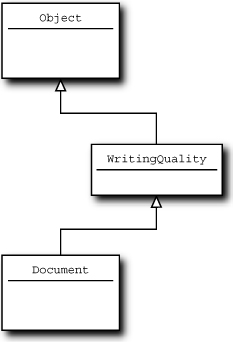
This explains how the module methods appear in the including classes—they effectively become methods just up the inheritance chain from the class.
Although including a module inserts it into the class hierarchy, Ruby is a bit circumspect about this fact: No matter how many modules a class includes, instances of the class will still claim to be, well, instances of the class. So, if my_tome is an instance of ElectronicBook, then my_tome.class will return ElectronicBook no matter how many modules the ElectronicBook class includes. Module inclusion is not a complete secret, however. You can discover whether the class of an instance includes a given module with the kind_of? method. So if Document includes the WritingQuality module, then my_tome.kind_of?(WritingQuality) will return true. You can also use the ancestors method to see the complete inheritance ancestry—modules included—of a class, so that Document.ancestors might return the following array:
[Document, WritingQuality, Object, Kernel, BasicObject]
This “insert the module in before the superclass” mechanism is not just some implementation detail that’s liable to change at any moment. The way modules work is an integral part of the way that Ruby works. Nor is all of this purely academic—the module inclusion mechanism has some real, practical implications. For example, imagine that your company gets into the business of publishing political tracts such as congressional speeches and the Governor’s state of the state statement. Now, where politics are involved the rules of good writing change: Politics is where the clichés go when they die. Given this, you decide that there really is no point in reporting back on the number of clichés in political writing:
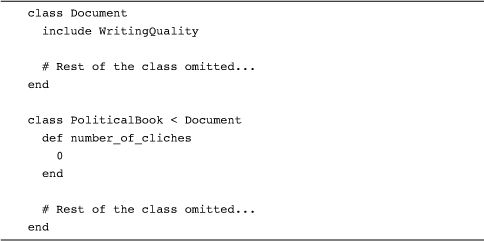
This seems like a sensible way to ensure that the number_of_cliches method always returns zero, but will it actually work? To put it another way, can you override a method in a module by defining that method in the class that includes the module?
Once you know that a mixin module effectively becomes a superclass when it is included, the answer is easy to come by: Yes. Since we know that the methods in a superclass cannot override the methods in subclasses, we can deduce that no module method can ever override a method in its host class. Call the method and Ruby will look first in the class, find it there, and never go looking in any included modules. So our PoliticalBook class above is indeed correct, and we can happily ignore political clichés.
A similar “who wins?” question arises if we have the same method in two modules and include them both in the same class. To see this in action, imagine that we decide to create a slightly tongue-in-cheek writing-quality module especially for political writing:

Now what happens if we include both the original writing-quality module as well as the political version above in our PoliticalBook class?

Which version of the number_of_cliches method will win? Again, the answer flows from the way modules get hooked into the class hierarchy of PoliticalBook: Include a module and it becomes the nearest parent “class” of the including class. Include a second module and it becomes the nearest parent of the including class, bumping the other module into second place. Have a look at Figure 16-2 to see this graphically. It’s the methods in the most recently included module that always win. In our example, the number_of_cliches from PoliticalWritingQuality would be the one that PoliticalBook would end up with.
Figure 16-2 Modules get inserted sequentially into the inheritance tree.
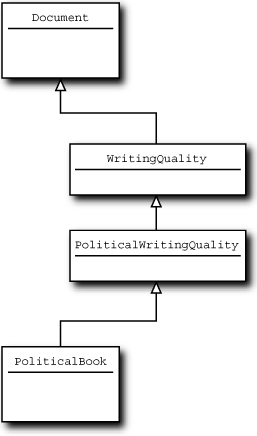
If you find yourself writing your own mixin module, there is one question that should be uppermost in your mind: What is the interface between my module and its including class? Since mixing in a module sets up an inheritance relationship between the including class and the module, you need to let your users know what that relationship is going to be before they start mixing. You should always add a few concise comments to your creation stating exactly what it expects from its including class:

A little guidance goes a long way to making your module useful.
In the Wild
Although the examples in this chapter have focused on modules containing a handful of methods, there really is no limit to what you can do with a module. DataMapper3 is a great example of just how far you can take a mixin module. DataMapper is an object relational mapper along the lines of ActiveRecord. Like ActiveRecord, DataMapper’s purpose is to make objects persistable in a database. But unlike ActiveRecord, DataMapper does not require that your persistable objects extend any particular class. Instead, it’s all done with a module. Here’s what our Document class might look like as a DataMapper object:

By including one module—DataMapper::Resource—your class gains all the equipment it needs to persist itself in a database, and does so without using up the single superclass that Ruby allows for each class.
Rails also makes heavy use of mixin modules, most notably in the form of helpers. The Rails helper methods do exactly what their name suggests: They help you. For example, Rails includes a large number of helper methods that ease the pain of creating HTML, methods like label and radio_button, all delivered to your classes courtesy of mixin modules:
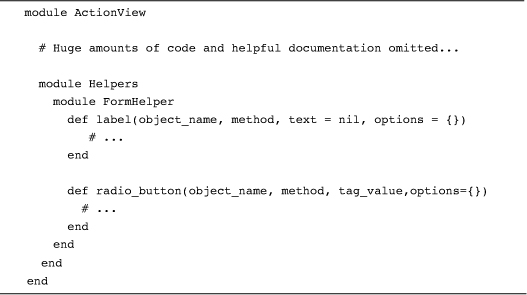
Nor are methods all you can get from a mixin module. Mixin modules are also very convenient places to stash constants. Since including a module in a class inserts the module into the class hierarchy, the including class not only gains access to the module’s methods but also to its constants. You can see this at work in the sqlite3 gem, which defines a series of modules full of nothing but constants. For example, there is a module that contains the list of error codes that might come back from sqlite3:4
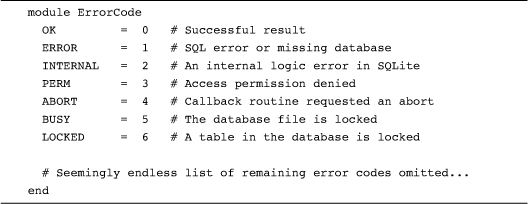
Now, as we saw in the last chapter, you can access all of these constants using their fully qualified names by saying things like ErrorCode::OK or ErrorCode::Busy. This can get tedious if you are doing it a lot; if so, you can drop the qualifying module name by simply including the ErrorCode module:
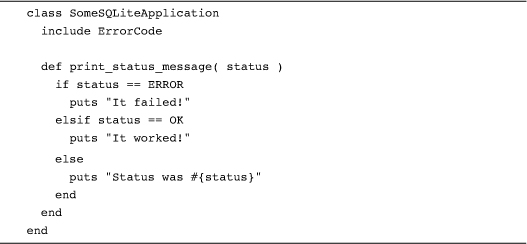
Nothing like being able to insert modules into your class hierarchy to make the workday go faster!
Wrapping Up
In this chapter we have seen how mixin modules solve the problem of code that needs to be shared among classes without using up the one alloted superclass. We have also seen how mixin modules work, how they get drafted into service as a kind of phantom superclass when they are included into a host class. We have also seen that the key issue with mixins is the interface between the host class and the mixin module—what methods does the module provide and what does it expect the class to supply?
For many new Ruby programmers, mixin modules can act as a sort of skeleton key to the whole philosophy behind the language, the elegant way that Ruby tries to help programmers get code to execute where it is needed. Because of this, mixin modules pop up somewhere in most real-world Ruby applications. Nor are we done with them. Mixins will make an encore appearance in Chapter 20 when we look at a slick way to add both instance and class methods to a class with a single include. For now, however, we will turn to the code block, another way of getting code to where you need it.

